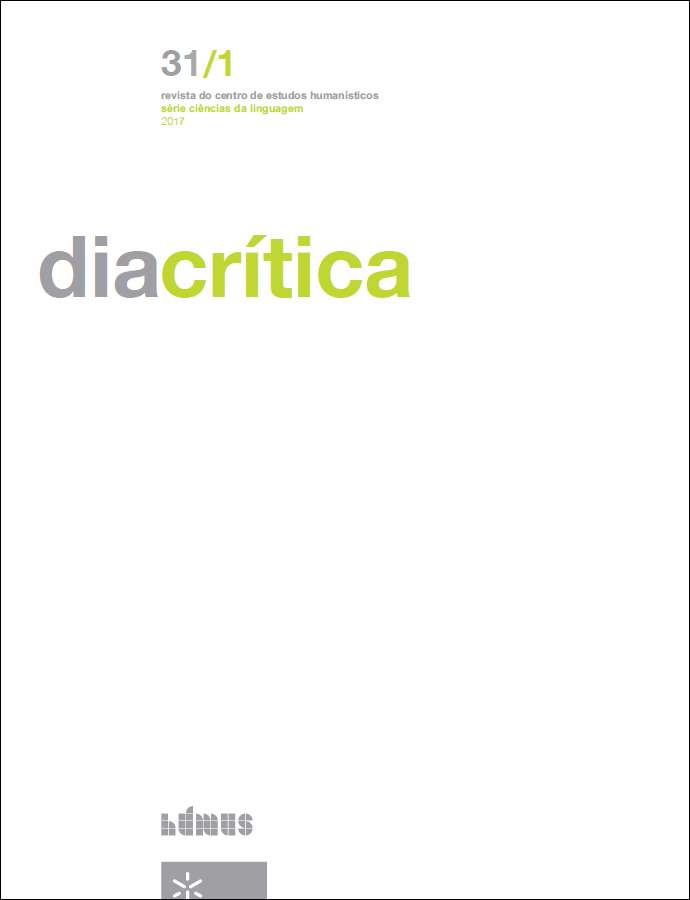Beyond the waves. A starting point about the social meaning of the variation between final unstressed nasal diphthong and oral vowel in Brazilian
DOI:
https://doi.org/10.21814/diacritica.4918Keywords:
variation, evaluation, speech styleAbstract
This paper presents the result of a study about the social meaning of the variation between final unstressed nasal diphthong and oral vowel, such as in homem ~ homi, from the observed behaviour of Brazilian Portuguese speakers according to speech style constraint. Moreover, it also presents a reflexion on the different “waves” or approaches of the social meaning of linguistic variation as presented by Eckert (2012) to locate the starting point of this study on the set of analytical practices for the study of variation developed within the Sociolinguistic approach. It is argued that the study of the social meaning of variation constitutes an interdisciplinary challenge that must encompass both macro and micro-social issues. Specifically in relation to the object of study, the results for speech style indicated that the variation presents stylistic stratification, a typical feature of a sociolinguistic marker.
References
Battisti, E. (2002). A redução dos ditongos nasais átonos. In: Bisol, L.; Brescancini, C. (Orgs.) Fonologia e variação - recortes do português brasileiro. Porto Alegre: EDIPUCRS, 183-202.
Bell, A. (1984). Language style as audience design. Language in Society, 13(2), 145-201.
Bortoni, S. M., Gomes, C. A., Malvar, E. (2003). The Principle of Saliency Revisited. In: Schlieben-Lange, B.; Koch, I. V., Jungbluth, K. (Orgs.) Dialog Zwischen den Schulen: Soziolinguistische, konversationanalytische und generative Beiträge aus Brasilien. Münster: Nodus Publikationen, 61-72.
Bybee, J. (2001). Phonology and language use. Cambridge: Cambridge University Press.
Bybee, J. (2015). Language Change. Cambridge: Cambridge University Press.
Chambers, J. K. (2002). Patterns of variation including change. In: Chambers. J. K., Trudgill, P., Schilling-Estes, N. (orgs.) The Handbook of Language Variation and Change. Oxford: Blackwell, 349-372.
Coetzee, A., Kawahara, S. (2013). Frequency biases in phonological variation. Natural Language and Linguistic Theory 40(1), 47-89.
Eckert, P. (1989). Jocks and Burnouts: Social Categories and Identity in the High School. New York: Teach. Coll. Press.
Eckert, P. (2000). Linguistic Variation as Social Practice. Oxford: Blackwell, 2000.
Eckert, P. (2012). Three waves of variation study: the emergence of meaning in the study of sociolinguistic variation. Annual Review of Anthropology, Palo Alto, 41, 87-100.
Eckert, P. (2015). Variation, convention, and social meaning. Paper Presented at the Annual Meeting of the Linguistic Society of America. Oakland, CA. Jan. 7, 2005. Disponível em: < http://lingo.stanford.edu/sag/L204/EckertLSA2005.pdf >. Acesso em: 22 mar. 2016.
Gurvitch, G. (1982). As classes sociais. São Paulo: Global Editora.
Guy, G. R. (1981). Linguistic variation in Brazilian Portuguese: aspects of the phonology, syntax, and language history. PhD Dissertation, University of Pennsylvania.
Hora, D., Wetzels, L. (2011). A variação linguística e as restrições estilísticas. Revista da ABRALIN, n. esp., 147-188.
Labov, W. (1966). The Social Stratification of English in New York City. Washington, DC: Center for Applied Linguistics.
Labov, W. (1972a). The isolation of contextual styles. In Labov, W. Sociolinguistic Patterns. Philadelphia: University of Pennsilvania Press, 70-109.
Labov, W. (1972b). The reflexion of social processes in linguistic structure. In Labov, W. Sociolinguistic Patterns. Philadelphia: University of Pennsilvania Press, 110-121.
Lopes, L. W., Lima, I. L. B. (2015). Estilo e atitudes linguísticas quanto ao processo de palatalização das oclusivas dentais. Revista da ABRALIN, 14(1), 247-272.
Meyerhoff, M. (2008). Introducing Sociolinguistics. London: Routledge.
Milroy, L. (1987). Language and Social Networks. Oxford: Blackwell.
Milroy, L. (2002). Social Network. In: Chambers. J. K.;Trudgill, P.; Schilling-Estes, N. (Orgs.) The Handbook of Language Variation and Change. Oxford: Blackwell, 594-572.
Munson, B., Edwards, J., Beckman, M. (2005). Phonological knowledge in typical and atypical speech–sound development. Topics in Language Disorders 25(3), 190-206.
Oushiro, L. (2015). Identidade na pluralidade: avaliação, produção e percepção lin guística na cidade de São Paulo. Tese de Doutorado. USP.
Pierrehumbert, J. B. (2003). Probabilistic Phonology: Discrimination and Robustness. In: Bod, R.; Hay, J.; Jannedy, S. (Orgs.) Probability Theory in Linguistics. The MIT Press: Cambridge MA, 177-228.
Pierrehumbert, J. B. (2016). Phonological representation: Beyond abstract versus episodic. Annual Review of Linguistics 2, 33-52.
Silverstein, M. (2003). Indexical order and the dialectics of sociolinguistic life. Language & Communication. 23, 193–229.
Schilling-Estes, N. (2002). Investigating Stylistic Variation. In: Chambers. J. K.,Trudgill, P., Schilling-Estes, N. (Orgs.) The Handbook of Language Variation and Change. Oxford: Blackwell, 375-401.
Schwindt, L. C., Silva, T. B. da (2010). Panorama da redução da nasalidade em ditongos átonos finais no português do sul do Brasil. In: Bisol, L., Collischon, G. (Orgs). Português do sul do Brasil: variação fonológica. Porto Alegre: EDIPUCRS, 15-30.
Schwindt, L. C., Silva, T. B. da, Quadros, E. S. de (2012). O papel da morfologia na redução da nasalidade em ditongos átonos finais no português do sul do Brasil. In: Lee, S-H. (Org.). Vogais além de Belo Horizonte. Belo Horizonte: Editora da UFMG, v. 1, 349-359.
Tarallo, F., Duarte, M. E. L. (1988). Processos de mudança linguística em progresso: a saliência vs não saliência de variantes. Ilha do Desterro, 20, 44-58.
Votre, S. (1978). Aspectos da variação fonológica na fala do Rio de Janeiro. Tese de Doutorado. Universidade Federal do Rio de Janeiro.
Weinheich, U, Labov.W, Herzog, M. (1968). Empirical Foundations for a Theory of Language Change. In: Lehmann, P., Malkiel, Y. (Orgs.) Directions for Historical Linguistics. Austin: University of Texas Press, 95-188.
Zhang, Q. (2005). A Chinese yuppie in Beijing: phonological variation and the construction of a new professional identity. Language in Society, 34, 431–66.
Downloads
Published
How to Cite
Issue
Section
License
Copyright (c) 2023 Christina Abreu Gomes

This work is licensed under a Creative Commons Attribution-NonCommercial 4.0 International License.










